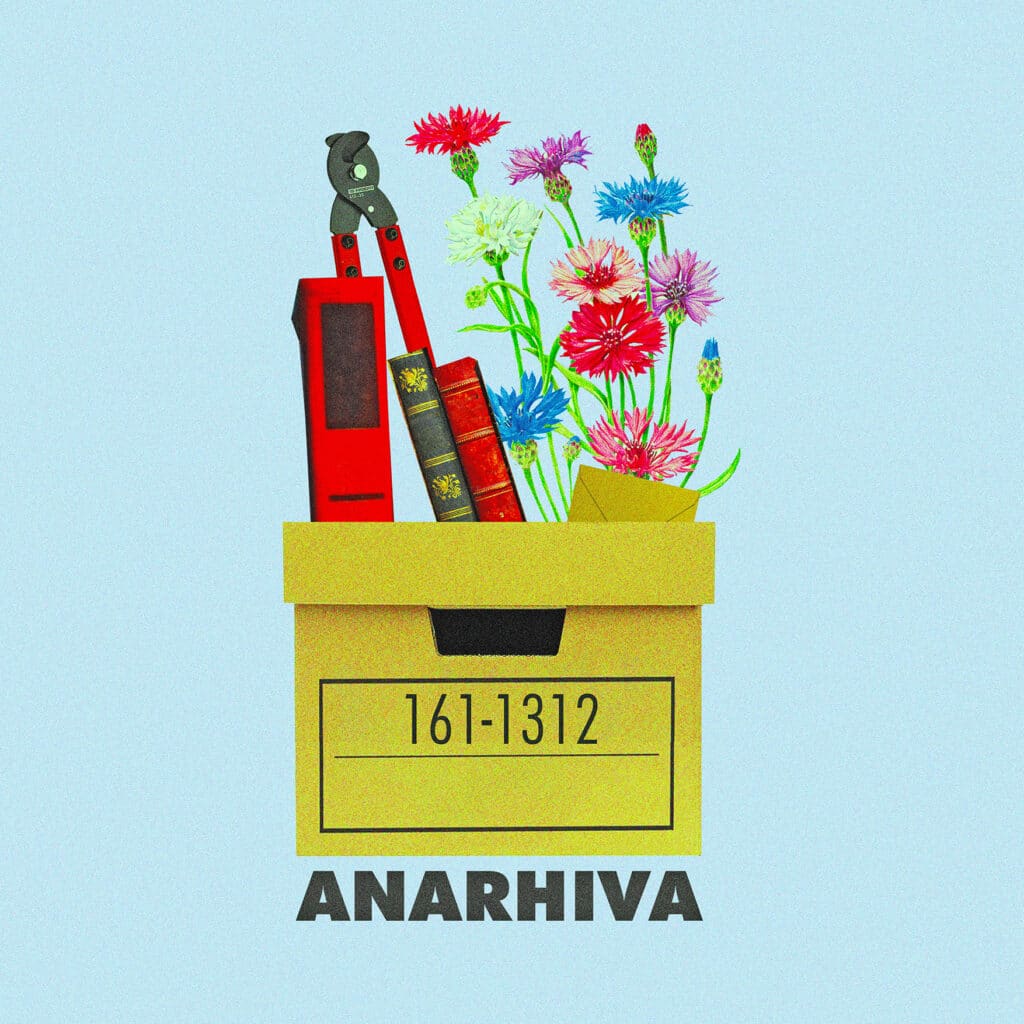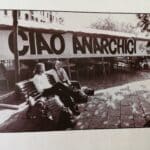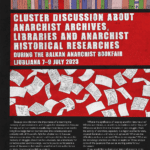Bună: What kind of materials do you collect?
Anarhiva: Most of the materials reflect the multiple ways of self-organization and anarchist struggle in the past 150 years in Romania. This means that we bring together both classical materials, such as historical correspondence, manuscripts, periodical journals, brochures, books, photographs etc., but also what modern day archives and libraries would not consider worthy of public interest, such as ephemeral prints published by anarcho-punk collectives: D.I.Y. zines, small leaflets, posters, anarchist manifestos, or even graffiti. We have also started a small video and audio library. So, we are speaking of roughly all media and publishing formats.
Do you also collect anarcho-syndicalist materials?
Although, historically speaking, anarcho-syndicalism has not been a dominant trend in Romania, like in Spain, France or other countries, it still was (and continues to be) an important part of the local anarchist organizing. There are several historical materials dedicated to the workers’ revolutionary struggle in our archive. For instance, there is Mișcarea Socială, a journal published in 1911 by Iuliu Neagu Negulescu (1878-1940), renowned anarchist, utopian writer and syndicalist militant. We have also included more recent publications in our collection: for instance Acțiunea Directă and Anarhia from 2012. In these two publications one can also find information about the ”classical” period of syndicalist and anarchist activity in Romania, and about some of its most prominent figures: Ștefan Gheorghiu, Panait Mușoiu, Iuliu Neagu-Negulescu. Other interesting documents about workers rights and organizing have been published in 2017 by Mahala – Comunitatea Muncitorilor Militanți (Mahala – The Community of Militant Workers) and some of them can be found in the archive.
Do you also collect anarchist material from other countries ?
The focus of our collection is the anarchist movement in Romania. However, a significant proportion of the anarchist material we are indexing is international. The anarchist movement has been (and still is) defined by its transnational character. Anarchism in Romania is no exception to that. We have documents from some of the countries where anarchists from Romania resided, traveled or emigrated to (or from): correspondence, journal articles, publications, pamphlets etc. There are a number of well-known international militants that ”crossed paths” with anarchists from Romania. For instance, Zamfir C. Arbure’s collaboration with Mikhail Bakunin, or his life-long friendship with Elisée Reclus. They both worked together for La Commune – Alamanch Socialiste, published in 1877, and eventually printed another magazine in Switzerland, Le Travailleur; or Max Nettlau’s correspondence with Panait Mușoiu, who also corresponded with Jean Grave and Paraf-Javal. Not to mention autochthonous figures which went international, such as Benzion Liber, Joseph Ishill, Eugen Relgis, Nicolas Trifon. We also index other documents related to Romania, such as international publications (in german, english, french, italian etc.), for instance Abolishing Border from Below or Bună. Zeitschrift für Befreiung & Emanzipation – nicht nur in Rumänien; or articles such as the memoirs of Mechel Stanger, published in Sweden in the 70s, or Relgis’s short history of libertarian and pacifists from Romania, published in France in 1951-52.
How do you get materials and publications ?
Most of the materials are part of our own and our comrades’ from Iași, Bucharest, Craiova, Timișoara, Cluj-Napoca personal collections. We have also spent some time in archives and libraries across the country and abroad in order to uncover historical prints related to the anarchist movement. Equally important, and a much appreciated help, was offered by various autonomous collectives (past and present): A-casă, Macaz, Armonia, D.I.Y. Craiova, Biblioteca Alternativă, LMA. Of course, we are looking forward to further exploring archives and finding new material. We are also in touch with local and international historians interested in social movements, anarchist literature, publishing etc.
What time periods does your archive cover?
At the moment the archive is organized in collections spanning five time periods, starting with the XIXth century. After that, the first half of the XXth century, or 1900-1947 (the year 1947 marking the beginning of the stalinist regime); a third period from 1947 to 1989 (when the ”communist” dictatorship was overthrown); a fourth period, from 1990-2001, or the first ten years of ”capitalist transition”; and, finally, from 2001 to present day, but with a 5 year buffer for safety reasons. With few exceptions, most of the public collections of the archive end around 2015/2016.
Can you say something about the epochs during which the greatest anarchist publishing activity took place in the country?
From a historical point of view, the periods of anarchist development in Romania are slightly different: the ”nihilist” or ”narodnik” period (1870-1892), the actual anarchist period (including here a ”stirnerite” trend, a syndicalist and a socialist libertarian one), between 1892-1918. During the interwar period, while there were still some syndicalist groups active, most of the activity and propaganda was dedicated to issues like pacifism, humanitarianism, esperantism, vegetarianism/veganism etc. This would be the third period, ending abruptly in 1947. After that, during the so-called ”communist” rule, anarchists either fled abroad, like Eugen Relgis, or kept a low profile, like A. Gălățeanu. A fifth period starts after the 1989 uprising. Anarchist ideas, practices and publications sprung up from the punk, hardcore and undergound scenes. Zines, concerts, protests against the war, food not bombs, anti-racist and anti-capitalist actions, anarcha-feminist festivals, shaped a distinctly anti-authoritarian ”culture of resistance”. This period ended rather abruptly in 2008/09, after the anti-NATO protest in Bucharest, when punks, anarchists and anti-war militants were violently repressed by the authorities. Roughly from 2012-2013, during the anti-austerity protests and the Roșia Montană campaign, the activity picked up again, with autonomous collectives organizing in the big cities. They included anarcho-syndicalist publications, feminist zines and actions, punk and FnB collectives, autonomous libraries etc.
If we were to point out, as you have asked, the most important periods of anarchist activity, they would be the 1892-1918 period, when Panait Mușoiu was active and editing Revista Ideei (1900-1916), the most important anarchist publication in Romania. The second period would be the ”anarcho-punk” years until 2008, as testified by the numerous zines, bands, concerts and overall anti-authoritarian initiatives documented in the archive.
Who was the target public for anarchist publications ?
This depends, of course, on the specific period you are looking at. For instance, during the ”narodnik” years, the main public were students (both university and college), writers, physicians etc. There were also attempts to reach a wider working class and peasant audience, but with mixed results. From around the 1890s, anarchist publications circulated among workers, small rural functionaries, teachers, even priests. For instance, Iuliu Neagu’s literary works, including his utopia, Arimania, were written (and seemingly intended) for a rural audience, as he prided himself to be a `a sort of peasant`. On the other hand, contemporary publications, such as zines or leaflets, were mainly written by punks involved in the underground movement, and were dedicated to a young readership. There were also other, more general publications, such as manifestos and pamphlets, that were aimed at a wider audience, including working-class readers; again, with overall mixed results. Nowadays, the main public are the urban readers – students, workers, activists, independent artists, teachers, ”lumpen-intellectuals” –, interested mainly in issues like migration, housing and working conditions, feminism, anti-racism, LGBTQ rights, animal rights etc.
Are there any regular anarchist publications in Romania today?
At the moment there are no regular Romanian anarchist publications. However, there are some zines and pamphlets published on a (more or less) regular basis. For instance zinefem, that we already mentioned before, the pamphlet collection from Pagini Libere, regularly updated, Strada, a magazine from Timișoara dealing mainly with housing justice issues etc. On the other hand, there are some left-leaning regular podcasts worth listening to. There is also an anti-authoritarian podcast, quite fun and informative, Leneșx Radio, that we actually recommend. It has some episodes in English too.
Do you publish on the anarchist history of Romania?
One of the many reasons for starting this project was to make these collections visible and to motivate others to get in touch and discover this hidden and frequently ignored tradition. A good example in this sense is the recent publication of This is (not) a love story!, a research concerning the history of anarcha-feminism and radical feminism in post-communism Romania. The author actually found the anarcha-feminist zine Lovekills via Anarhiva. Another example is the recent publication by the Pagini Libere editorial collective of a series of interviews with Nicolas Trifon, an anarchist from Romania who was active in France during the ‘80s. Some of the materials used for this anthology were already available in our collection. Moreover, members of Anarhiva were also involved in the actual publishing of this collection of interviews. It comes without saying that we encourage people to explore the archive, and to use it for their research, or to discover, generally speaking, different ways of organizing and viewing things. We also encourage people outside Romania to contact us if they’re interested in specific topics that they wish to explore in more detail.
Is the archive accessible to anyone interested?
The archive is freely accessible online. The search engine is quite easy to use, as you can identify any item by author, title, year, place, collection, subject, tag etc. We also have a printable annual bulletin and we regularly post brief descriptions of new entries on our facebook page. Soon a newsletter and a physical archive will be put together. We also plan to put up a blog with brief entries related to the indexed documents.
Are you in contact with anarchist archives from other countries?
We are in contact with a number of archives and libraries dedicated to the research of anarchism. We could mention here Centre International de Recherches sur l’Anarchisme (CIRA) in Lausanne, Centro di studi libertari ”Giuseppe Pinelli” in Milano, and Kate Sharpley Library from London. More recently we started to follow the online work carried out by the Tyneside Anarchist Archive. We also benefited from a lot of support with technical equipment from the Hafnerstrasse collective and Koch Areal from Zürich. Of course, we would like to be in touch with as many collectives or independent researchers as possible, especially regarding archival work, publishing, or documents related to anarchists from Romania.
How do you finance yourselves?
This is a D.I.Y. initiative, totally independent, so we cover all the expenses ourselves. Fortunately, they are not very high for the time being. However, we welcome any contributions that might be helpful in developing this project further: from archive material and various documents, to technical equipment and supplies related to the archival process (scanners, copy machines etc.). As we want to set up a physical archive and acquire various documents for it, we intend to put out some merch (T-shirts, tote bags, stickers) and to print some issues from our annual bulletin, in order to raise some funds for the project, but also for other political struggles.
How can one get in contact with you?
It is quite easy: drop us an e-mail at anarhivaa@gmail.com, or a message on our facebook page www.facebook.com/anarhivaro or instagram page www.instagram.com/anarhivaro/.
Thank you for this interview.
April 2021
A German version of this interview is available in Bună magazine, issue 9 / 2022.
***
Also, if you wish to support Anarhiva’s work, they have recently created a PayPal account: https://paypal.me/anarhivaro








